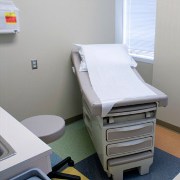 Photo: Getty Images
Photo: Getty Images
Obese women with body mass index of 40 or greater are less likely than non-obese women to receive screening tests for cancer, including Pap smears, pelvic exams, clinical breast exams, and mammograms. Dr. Jeanne M. Ferrante and colleagues at the University of Medicine and Dentistry of New Jersey investigated the reasons for this with a survey of 255 family physicians. They found that barriers to cancer screening fall into three categories: difficulty in performing the exams, inadequate equipment, and patient reluctance. In a separate study, Dr. Nisa M. Maruthur and colleagues at The Johns Hopkins University School of Medicine in Baltimore, Maryland, found that obese women are less likely than non-obese women to receive mammograms.
Doctors in Ferrante's study reported that pelvic and breast exams are more difficult when the patient is obese, and some explained that they are afraid to perform an exam that does not provide adequate information. Getting the patient on the table can be a challenge as well. “I have the fear that I'm going to get the person up in that position and then not be able to get the job done,” one doctor responded.
Standard exam tables, speculums, and gowns are often inadequate for extremely obese patients. “The biggest obstacle that I've faced with obese patients is that I have to purchase special equipment that costs a significant amount of money that I can't use on a significant portion of my population,” another doctor reported.
Even when doctors have the right equipment and experience with examining obese patients, they have more challenges in persuading these patients to get the exams. Ferrante's study identified embarrassment, pain or discomfort, limited mobility, other priorities, and the perception of disrespectful treatment from health care providers as causes for extremely obese patients to refuse screening. Maruthur pointed out that for mammograms, obesity is actually an advantage in terms of sensitivity of the X-ray picture for detecting cancer. Unfortunately, obese women may not perceive mammograms as a priority, or may find them painful because the breasts are compressed.
Ferrante recommended that better education for physicians, adequate equipment for patients of all sizes, and encouragement for all patients to receive recommended screenings.
References:
Ferrante JM et al, “Family physicians' barriers to cancer screening in extremely obese patients”, Obesity (Silver Spring). 2010 June; 18(6): 1153-59. http://www.ncbi.nlm.nih.gov/pubmed/20019676
Maruthur NM et al, “Obesity and mammography: A systematic review and meta-analysis”, J Gen Intern Med 24(5): 665-77. http://www.ncbi.nlm.nih.gov/pubmed/19277790
Reviewed May 30, 2011
Edited by Alison Stanton
Linda Fugate is a scientist and writer in Austin, Texas. She has a Ph.D. in Physics and an M.S. in Macromolecular Science and Engineering. Her background includes academic and industrial research in materials science. She currently writes song lyrics and health articles.





Add a CommentComments
There are no comments yet. Be the first one and get the conversation started!